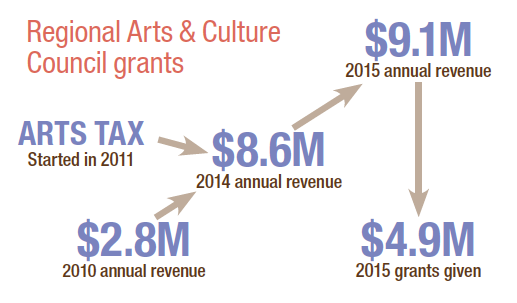Public funding for the arts in the U.S. has always lagged behind first-world countries, with Germany outpacing this country’s arts funding by 40-to-1.
But with the passage of Portland arts tax, arts funding in Oregon’s largest city is on the rise — continuing a 15-year trend. (See graph below on funding for the Portland-based Regional Arts & Culture Council.)
The Oregon Cultural Trust, founded by the state Legislature in 2002, has distributed millions of dollars to arts programs across the state. Funded by license-plate sales and a tax credit for donors, the public program intends to distribute a record $2.6 million in the 2015-16 fiscal tax year, up 30% after a strong fundraising effort and a new distribution formula approved by policymakers.
Arts funding consultant Claire Willett, who has worked for major institutions in the state, says she’s not yet ready to celebrate. Government arts funding often comes with strings attached, including requirements to measure performance, reach underserved communities or develop metrics of effectiveness — and that’s not how most arts institutions are organized.
Meanwhile, private support for the arts is dwindling — in part because of philanthropy’s shift to support schools, social services for the poor and other areas government no longer provides for.
A small boost in government funding will not make up for a large drop in philanthropy, she says. “In the 12 years I’ve been in the arts, government funding has been the smallest slice of the pie for Oregon arts.”
Though state-specific figures are not available, the National Endowment for the Arts estimates that U.S. arts nonprofits get about 6.7% of annual funds through federal, state and local tax dollars, with 38.2% coming from private donations — and endowments and program revenue comprising the rest.
Willett worries that in the future those private donations could drop precipitously. The James F. and Marion L. Miller Foundation, historically a major funder of arts in the state, last year revised its grant priorities, and the Meyer Memorial Trust is likewise funding fewer arts programs through its grants, as these institutions pivot toward education, youth and other needs perceived as more dire, she says.
The Paul G. Allen Family Foundation, which used to fund Oregon arts groups, pulled back from the state after the 2008 financial crisis, and today focuses mostly on Seattle.
“With foundations cutting back, we feel it,” Willett says. “Now arts organizations have to find new ways to make up the holes in their budgets.”



